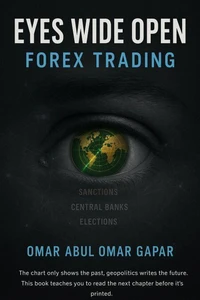"Mastering Price Action: The Definitive Guide to Reading the Market's Language" is not presented as a simple collection of trading patterns, but as a philosophical guide to a specific trading mindset. The author establishes from the outset that successful trading is not about finding a "holy grail" to predict the market, a quest deemed futile. Instead, the core philosophy is that price action trading is about reaction, not prediction.
The market is described as a continuous auction, a battle between bulls and bears where every price movement reflects the collective actions and emotions of all participants. The trader's role is to read the "footprints" of this battle at key price levels, assess the current balance of power, and align with the probable victor. This approach is built upon three fundamental pillars: Assessing Probabilities: The focus is on identifying high-probability scenarios, not guaranteed signals.
A trader becomes a master of "if-then" statements, acting only when price behaves in a specific way at a key location, indicating a statistical edge. Managing Risk: This is the non-negotiable foundation of trading. Risk management is not a separate task but is woven into every setup. The primary question before any trade is where the trading thesis is invalidated and how much capital is at risk, ensuring survival through losing trades.
Reacting to Information in Real-Time: Price action is treated as a live feed of the market's narrative, unlike lagging indicators that provide historical data. The trader learns to be a passive observer until a clear setup manifests, then becomes a decisive actor. The journey of learning price action is framed as learning a new language-the "primal language of the financial markets." This involves learning its grammar (candlesticks), syntax (support and resistance), and poetry (market structure).
The path requires discipline, patience, and emotional control to ignore external noise and listen only to the market. Losses are reframed as an inevitable "tuition fee, " with the ultimate goal being to keep losses small and manageable while allowing winners to be significantly larger. The reader is encouraged to approach the book with an open mind, ready to learn a way of thinking rather than just memorizing patterns.
"Mastering Price Action: The Definitive Guide to Reading the Market's Language" is not presented as a simple collection of trading patterns, but as a philosophical guide to a specific trading mindset. The author establishes from the outset that successful trading is not about finding a "holy grail" to predict the market, a quest deemed futile. Instead, the core philosophy is that price action trading is about reaction, not prediction.
The market is described as a continuous auction, a battle between bulls and bears where every price movement reflects the collective actions and emotions of all participants. The trader's role is to read the "footprints" of this battle at key price levels, assess the current balance of power, and align with the probable victor. This approach is built upon three fundamental pillars: Assessing Probabilities: The focus is on identifying high-probability scenarios, not guaranteed signals.
A trader becomes a master of "if-then" statements, acting only when price behaves in a specific way at a key location, indicating a statistical edge. Managing Risk: This is the non-negotiable foundation of trading. Risk management is not a separate task but is woven into every setup. The primary question before any trade is where the trading thesis is invalidated and how much capital is at risk, ensuring survival through losing trades.
Reacting to Information in Real-Time: Price action is treated as a live feed of the market's narrative, unlike lagging indicators that provide historical data. The trader learns to be a passive observer until a clear setup manifests, then becomes a decisive actor. The journey of learning price action is framed as learning a new language-the "primal language of the financial markets." This involves learning its grammar (candlesticks), syntax (support and resistance), and poetry (market structure).
The path requires discipline, patience, and emotional control to ignore external noise and listen only to the market. Losses are reframed as an inevitable "tuition fee, " with the ultimate goal being to keep losses small and manageable while allowing winners to be significantly larger. The reader is encouraged to approach the book with an open mind, ready to learn a way of thinking rather than just memorizing patterns.

 , qui est-ce ?
, qui est-ce ?